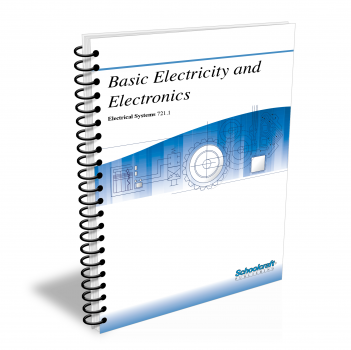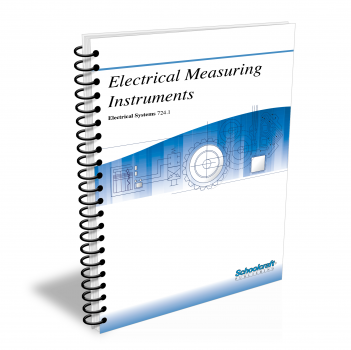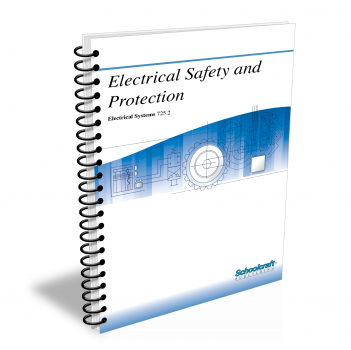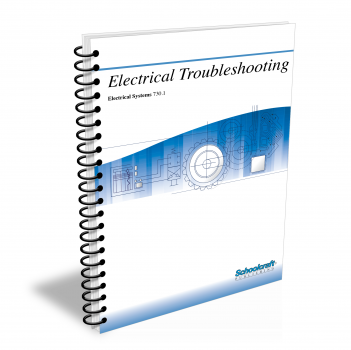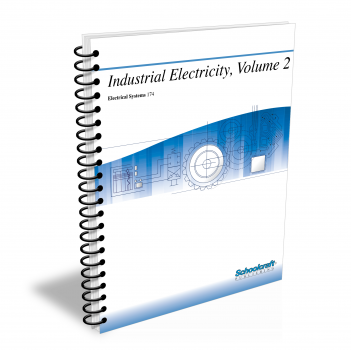Industrial Electricity Vol 1
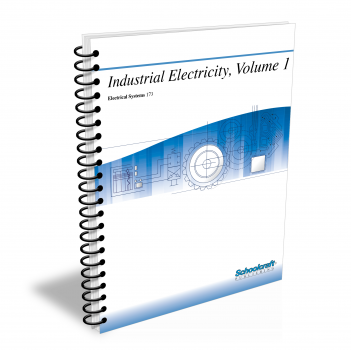
Course Number: 8173
The two volumes of this textbook can be used independently or in conjunction with each other. They orient students to not only the principles of electricity and single-phase and three-phase motors but also on maintaining and troubleshooting controls and motors. The Industrial Electricity Vol. 1 textbook includes an overview of the principles of electricity and circuit analysis, and the installation and maintenance of single-phase motors.
Does your curriculum require additional topics not included in this textbook? Build a customized version of the Industrial Electricity Vol. 1 textbook below.
Recommended Contact Hours – 23
Preview a Chapter
Available Supporting Material
- Table of Contents
- Exam Copies
- Suggested Titles
Table of Contents
Chapter 1: Current Resistance and Voltage
Topics: Electric current, resistance, and potential difference; Ohm's Law; Resistance and voltage drop; Electrical measurement
Learning Objectives:
- State the characteristics of an electrical conductor and an electrical insulator.
- State the definition of electric current.
- Explain the relationship of potential difference to the flow of electric current.
- State the definition of Ohm's Law.
- Identify the purpose and parts of an ammeter.
Chapter 2: Electrical Components
Topics: Resistors; Color code and power rating; Capacitors; Connecting capacitors; Induction; Inductors; Solenoids and relays
Learning Objectives:
- Identify symbols for resistors, capacitors, and relays in an electric circuit diagram.
- Explain the operating principles of resistors, capacitors, and inductors.
- State the meaning of each band in the resistor color-code system.
- List the factors to consider when choosing a resistor.
- Explain how to connect capacitors in parallel and in series.
Chapter 3: Conductors
Topics: Sizes and classifications; Insulation; Protecting conductors; Flexible conduit; Conduit fill; Splicing conductors
Learning Objectives:
- Explain the difference between a conductor and an insulator.
- Identify a bare conductor, a covered conductor, an insulated conductor, a stranded conductor, a cable, and a cord.
- State the definitions of insulation resistance and dielectric strength.
- Select the best tapes for insulating splices, restoring the outer protecting covering on a splice, and connecting motor leads.
- Explain how to make a pigtail splice and a fixture splice.
- State the purposes of cable protection.
Chapter 4: AC Electricity
Topics: Advantages of AC; Generating alternating current; Resistance, inductance, capacitance, current, and power in AC circuits
Learning Objectives:
- Explain the importance of the transformer in ac electricity.
- Explain what a complete cycle of ac consists of and how it is produced.
- State the definition of ac inductance.
- List the ways inductive reactance differs from resistance.
- Explain the difference between the terms in-phase and out-of-phase in an ac circuit.
Chapter 5: Series-Parallel Circuits
Topics: DC motors and generators; Voltage dividers; Lighting circuits; Three- and four-way switch circuits
Learning Objectives:
- State the definition of a series-parallel circuit.
- Identify series, parallel, and series-parallel circuits.
- Explain how to calculate resistances in a series-parallel circuit.
- Demonstrate how to trace and simplify a circuit.
Chapter 6: Principles of AC Circuits
Topics: AC and DC electricity; AC waveform; Peak-to-peak, average, effective values; Energy storage; Faraday's Law; Basic circuit concepts
Learning Objectives:
- State of definition of a waveform.
- Demonstrate how to calculate the frequency of an alternator's output.
- Explain how to calculate an effective value.
- Name the kinds of values that must be used when applying the dc rules and laws to ac circuits.
Chapter 7: Mathematics in AC Circuits
Topics: Potential difference; Angles and degrees; Vectors applied to AC circuits; Graphic and math solutions; Calculating instantaneous values
Learning Objectives:
- Describe a triangle.
- State the definition of a vector.
- Identify the vector representing resistance in a vector diagram.
- Demonstrate how to calculate the total impedance in an ac circuit.
Chapter 8: Inductance and Inductive Reactance
Topics: Factors affecting inductance; CEMF; Inductive reactance and time delay; Phase angles; Impedance; Mutual induction; Inductors
Learning Objectives:
- Name the property of a coil that makes it resist changes in current.
- List the factors that determine inductance in a coil.
- State the definition of counter electromotive force.
- Demonstrate how to convert a frequency in Hz to a frequency in radians per second.
Chapter 9: Capacitance and Capacitive Reactance
Topics: How a capacitor works; Factors controlling capacitance; Kinds of capacitors; Time constants; Capacitive reactance; Phase angle
Learning Objectives:
- Name the parts of a capacitor.
- List the factors that affect the amount of charge stored in a capacitor at a given potential difference.
- Demonstrate how to install a multisection electrolytic capacitor.
- State the definition of capacitive reactance.
Chapter 10: Impedance
Topics: Impedance in series circuits; Phase angles; Resonance in series circuits; Impedance in parallel circuits
Learning Objectives:
- State the definition of impedance.
- Explain how to calculate the impedance in a series ac circuit.
- Demonstrate how to find the value of a phase angle for a circuit.
- Explain how to calculate the impedance in a parallel circuit.
Chapter 11: Principles of Single-Phase Motors
Topics: Motor parts; NEMA motor standards and enclosures; Nameplate data; Induction motors; Stator, rotor field; Split-phase starting; Synchronous speed; Starting switches
Learning Objectives:
- List the parts of a rotor.
- List the data given on a typical motor nameplate.
- Explain how an induction motor works.
- Demonstrate how to calculate the number of electrical degrees in one complete rotation of a motor.
- Explain how a centrifugal switch works.
Chapter 12: Split-Phase Motors
Topics: Motor connections; Skein and consequent-pole windings; Two-speed, three-, four-winding, and dual-voltage motors; Troubleshooting
Learning Objectives:
- State the reason why a second stator winding is important in the single-phase induction motor.
- Explain how to identify motor leads when there are no tags or colors to identify them.
- Describe a skein winding.
- List the ways to change the speed of a motor by changing the number of poles.
- Discuss some common motor problems.
Chapter 13: Capacitor Motors
Topics: Kinds and operation; Rotating magnetic fields; Single-voltage, dual-voltage, reversible, capacitor-start, and capacitor-run motors
Learning Objectives:
- State the definition of a capacitor.
- Explain how to make a split-phase motor operate as a capacitor-start motor.
- Explain how the running windings are connected to make a dual-voltage motor run on either 120 or 240 volts.
- Select the best capacitor to use as a substitute for a defective capacitor when an identical unit is not available.
- List problems that cause the circuit breaker to trip when you turn on a capacitor motor.
Chapter 14: Motor Installation
Topics: Conductor size; Preventing shorts and grounds; Controllers; Overcurrent protection; Guards; Grounding; Fuses; Starters; Service factor
Learning Objectives:
- Explain how to determine conductor size for motors.
- State the definition of a controller.
- List the conditions under which the frames of stationary motors must be grounded.
- Demonstrate how to determine the size of a dual-element when two or more motors are connected to one feeder.
- List the electrical and mechanical factors to consider in selecting a motor for a specific application.
Chapter 15: Motor Maintenance
Topics: Procedures; Testing capacitors and stator windings; Armature defects; Noisy operation; Bearing problems; High temperatures; Incorrect speed
Learning Objectives:
- Demonstrate how to test bearings for wear.
- Explain how to test capacitors.
- State the reason why proper belt tension in important.
- List the common causes of excessive brush sparking.
Request Exam Copies
Exam Copies
Ready to see a copy of our textbooks? After selecting which textbooks you’d like to review for your course, you can submit your request by either logging in or creating an account so we know where to ship your exam copies. A representative from Schoolcraft will contact you to confirm and finish processing your request.
Exam copies are always free and yours to keep.
Selected Exam Copies
none selected
* Maximum of five copies can be ordered
